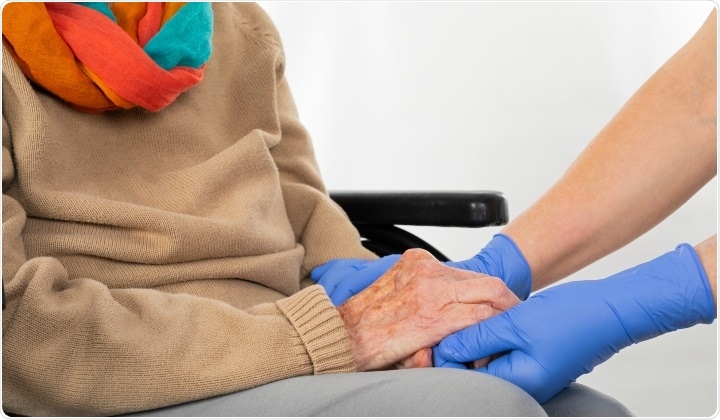The spread of Covid-19 inside care homes has been fueled by a lack of personal protection equipment (PPE) – according to new research from the University of East Anglia.

Researchers studying the spread of the virus in Norfolk care homes found that once the virus was present, its spread was most strongly linked to a lack of PPE, particularly facemasks and eye protection.
But the introduction of the virus into the homes wasn’t dependent on PPE but rather the total numbers of non-care staff working there.
Covid-19 was more likely to get into residential care homes when there were more non-care staff such as maintenance people, cooks and those in administrative roles.
The research is the first to observe how Covid-19 seems to enter and spread through care homes. Due to the rapid-response nature of this study, it has not yet been peer reviewed.
The team hope their work will help inform strategies to control the spread of Covid-19 and other contagious diseases in care homes.
Covid-19 has disproportionately more severe outcomes among the elderly and it has swept through residential care homes in the UK and abroad, with a high number of deaths. About 40 per cent of all Covid-19 deaths in the UK in early May 2020 were among care home residents. But preventing and controlling infectious disease outbreaks in care settings has many challenges. The sector is under-funded in many countries and staffed by low-paid workers who may have insufficient training or experience in infection control. It’s well known that here in the UK, care home workers were not supplied with sufficient personal protection equipment (PPE) such as masks, gloves and protective gowns early in the Covid-19 outbreak. This lack of PPE was widely suspected to have contributed to the spread of the disease and deaths in care homes. We wanted to see if lack of PPE could be linked to spread of Covid-19 in a real dataset of Norfolk care homes, and if any other factors seemed to be at play. We found that once Covid-19 was in a care home then the outbreak was worse where more care staff were employed, but this was much less important than whether they had shortages in certain types of PPE.”
Prof Paul Hunter, Infectious diseases expert, UEA’s Norwich Medical School
The research team looked at staffing levels and PPE availability in 248 care homes across Norfolk in April and early May using data available in the care home Capacity Tracker database, set up to help care homes flag their PPE needs and shortages.
The UEA researchers compared the prevalence of Covid-19 with the availability of aprons, eye protection, gloves, masks and hand sanitizer. They also looked at the number and types of staff working within the homes, including nurses, other face-to-face care workers and staff not involved directly with care.
Of the 248 care homes in Norfolk with complete data, 25 had definite or suspected cases of Covid-19 – about 10 per cent. We found that the number of non-care staff - such as cooks, maintenance people, and administrative staff - was linked with a higher risk of Covid-19 entering a care home. This is really interesting because these are not the people who are directly involved in the care of residents. We don’t know exactly why this is the case, but it may have been down to low use of PPE among these employees, which means they were more likely to pass on the infection to other staff or during brief time spent near residents. Alternatively, non-care workers may be more likely to work part time and possibly work across several locations.
Dr Julii Brainard, Lead researcher, UEA’s Norwich Medical School
The risk of Covid-19 entering a care home was just over six times higher in care homes that employed between 11 and 20 non-care workers, nearly 10 times higher in homes employing 21-30 non care workers, and almost 19 times higher in homes employing more than 30 non-care workers.
Dr Brainard said: “We also found that once introduced into the home, the subsequent spread of Covid-19 was largely associated with inadequate access to PPE, particularly facemasks and eye protection.
“Supplies of PPE to UK care homes have increased since our study monitoring period and we hope this has changed the balance of future risk factors.
“Although our research clearly indicated the importance of PPE to reduce disease spread, we believe that infection prevention and reduction needs to be more multi-faceted than simply supplying adequate PPE and training to use it.
“Low pay and job insecurity means that many people who work in care homes may need to work across multiple settings to have income security.
“Each setting they work in can mean more chances for exposure to infectious people, and higher chances of infection transfer between settings. This is a problem for infection control across the entire care sector.”
One limitation to the study is that the data did not indicate counts of agency workers who were most likely to work in multiple care homes. And a lack of ethnic diversity in Norfolk meant the team could not consider whether ethnicity was a factor in disease spread or severity.
Understanding how often care home staff work in multiple institutions, taking on which types of roles with what kinds of physical contact with patients and other staff may be key to preventing Covid-19 and other diseases from getting into care homes.”
Dr Julii Brainard
The study was led by UEA, in collaboration with Newcastle University.
It was funded by the National Institute for Health Research Health Protection Research Unit (NIHR HPRU) in Emergency Preparedness and Response at King’s College London in partnership with Public Health England (PHE) in collaboration with the University of East Anglia.
‘Introduction to and spread of COVID-19 in care homes in Norfolk, UK’ is published on the MedRvix preprint server.
Source:
Journal reference:
Brainard, J.S., et al. (2020) Introduction to and spread of COVID-19 in care homes in Norfolk, UK. medRxiv. doi.org/10.1101/2020.06.17.20133629.